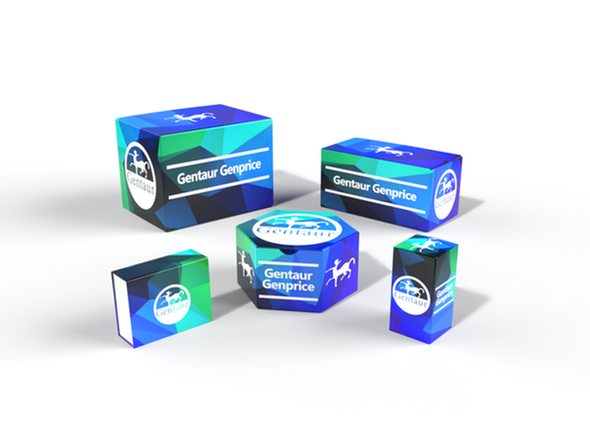749
Mouse Hepatocyte Growth Factor Receptor (C-MET/HGFR) ELISA Kit | KTE71050
- SKU:
- 749-KTE71050
- Availability:
- Usually ships in 5 working days
Description
Mouse Hepatocyte Growth Factor Receptor (C-MET/HGFR) ELISA Kit | KTE71050 | Gentaur UK, US & Europe Distribution
Application: This Mouse Hepatocyte Growth Factor Receptor (C-MET/HGFR) ELISA Kit employs a two-site sandwich ELISA to quantitate MET in samples. An antibody specific for MET has been pre-coated onto a microplate. Standards and samples are pipetted into the wells and anyMET present is bound by the immobilized antibody. After removing any unbound substances, a biotin-conjugated antibody specific for MET is added to the wells. After washing, Streptavidin conjugated Horseradish Peroxidase (HRP) is added to the wells. Following a wash to remove any unbound avidin-enzyme reagent, a substrate solution is added to the wells and color develops in proportion to the amount of MET bound in the initial step. The color development is stopped and the intensity of the color is measured.
Detection Method: Colorimetric
Conjugate: N/A
Sample Type: Cell culture supernatants#Serum#Plasma#Other biological fluids
Assay Type: Multiple steps standard sandwich ELISA assay with a working time of 3-5 hours. It depends on the experience of the operation person.
Kit Component: • Mouse Hepatocyte Growth Factor Receptor microplate
• Mouse Hepatocyte Growth Factor Receptor standard
• Mouse Hepatocyte Growth Factor Receptor detect antibody
• Streptavidin-HRP
• Standard diluent
• Assay buffer
• HRP substrate
• Stop solution
• Wash buffer
• Plate covers
Features & Benefits: Mouse Hepatocyte Growth Factor Receptor (C-MET/HGFR) ELISA Kit has high sensitivity and excellent specificity for detection of Mouse MET. No significant cross-reactivity or interference between Mouse MET and analogues was observed.
Calibration Range: Please inquire
Limit Of Detection: Please inquire
Usage Note: • Do not mix components from different kit lots or use reagents beyond the kit expiration date.
• Allow all reagents to warm to room temperature for at least 30 minutes before opening.
• Pre-rinse the pipet tip with reagent, use fresh pipet tips for each sample, standard and reagent to avoid contamination.
• Unused wells must be kept desiccated at 4 °C in the sealed bag provided.
• Mix Thoroughly is very important for the result. It is recommended using low frequency oscillator or slight hand shaking every 10 minutes.
• It is recommended that all samples and standards be assayed in duplicate or triplicate.
Storage Instruction: The unopened kit should be stored at 2 - 8°C. After opening, please store refer to protocols.
Shipping: Gel pack with blue ice.
Precaution The product listed herein is for research use only and is not intended for use in human or clinical diagnosis. Suggested applications of our products are not recommendations to use our products in violation of any patent or as a license. We cannot be responsible for patent infringements or other violations that may occur with the use of this product.
Background: Receptor tyrosine kinase that transduces signals from the extracellular matrix into the cytoplasm by binding to hepatocyte growth factor/HGF ligand. Regulates many physiological processes including proliferation, scattering, morphogenesis and survival. Ligand binding at the cell surface induces autophosphorylation of MET on its intracellular domain that provides docking sites for downstream signaling molecules. Following activation by ligand, interacts with the PI3-kinase subunit PIK3R1, PLCG1, SRC, GRB2, STAT3 or the adapter GAB1. Recruitment of these downstream effectors by MET leads to the activation of several signaling cascades including the RAS-ERK, PI3 kinase-AKT, or PLCgamma-PKC. The RAS-ERK activation is associated with the morphogenetic effects while PI3K/AKT coordinates prosurvival effects. During embryonic development, MET signaling plays a role in gastrulation, development and migration of muscles and neuronal precursors, angiogenesis and kidney formation. In adults, participates in wound healing as well as organ regeneration and tissue remodeling. Promotes also differentiation and proliferation of hematopoietic cells (By similarity) .
Alternative Names: MET; AUTS9; HGFR; RCCP2; c-Met; HGF receptor; SF receptor; met proto-oncogene; met proto-oncogene tyrosine kinase; oncogene MET; scatter factor receptor
Search name: MET; AUTS9; HGFR; RCCP2; c-Met; HGF receptor; SF receptor; met proto-oncogene; met proto-oncogene tyrosine kinase; oncogene MET; scatter factor receptor
Tag: MET










